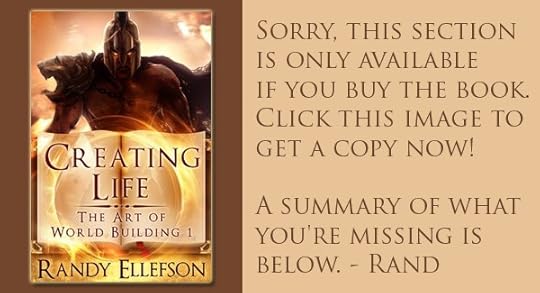Randy Ellefson's Blog, page 30
July 12, 2018
Understand Government Types
Most of us don’t find a discussion of government entertaining. We don’t want to research it and explain what’s going on to our audience any more than they want us to explain it to them. But stories can be improved when told by someone with a high understanding of different power structures and their sources. These can cause conflict that affect our characters, whether our story heavily features government characters or just causes life to be hard.
The usefulness of Earth analogues abound. Somalia’s destabilized government has caused pirates to seek a better life through plunder, which can affect us if we sail near. The United States is admired for personal liberties, causing millions to desire fleeing to it; it is also despised by dictatorships. Some countries are known for their corrupt governments, police, and drug cartels, and the resulting problems citizens face. Our world’s inhabitants should be aware of how desirable various kingdoms are or whether they should be avoided, and why.
This section provides details on the various sovereign power types. Entire books have been written on each, but we’re not going that deep here. If you need more detail, this section can help you decide which government type you want to create before making such a deep dive via another resource.
Each name for a government type has implications, but sometimes a sovereign power has the wrong name. The Empire of Kysh might be a federation if one “looked under the hood” at how its government functions. A dictatorship is unlikely to call itself one. World builders should strive to get it right most of the time, but we might like “Empire of Kysh” better than “Federation of Kysh”—or our inhabitants might have some reason for the deception/inaccuracy. We have some leeway here.
Another issue is that a government type doesn’t last forever in a given sovereign power. They rise and fall, replacing each other. For this reason, when writing in our world building files about our new sovereign power, include a note about what government type it has right now. We can also include other types from which it arose. Each will have left an impact on the present in some way, whether that’s structures, statues, or military. The cultural impacts will be felt, too, including languages spoken and general feelings among the population, such as relief or dread about the most recent change. Working these out is optional but adds color and depth.
Government types can be organized in various ways, such as by power structure or power source. The latter is used here.
The post Understand Government Types appeared first on The Art of World Building.
July 5, 2018
Branches of Government
This section discusses difference branches of government (executive, judicial, and legislative) and why separating them is important.
The post Branches of Government appeared first on The Art of World Building.
July 2, 2018
What is Head of Government?
The “head of government” is the person leading it. He has a title like prime minister or chancellor. This person might also be head of state, in which case they’ll have a title like king, emperor, or president. Be aware that the duties of a role, such as president, change from country to country. This means world builders have some leeway to give or take away rights from someone should our situation require it.
Writers tend to state someone’s title without providing much idea on the person’s powers. Some of this is natural to avoid some potentially boring exposition, but it might also be a lack of thought given to this subject. There are many potential acts various heads of government can do and it’s worth researching them to gain some idea. For example:
Can they veto laws or sign laws into existence by themselves?
Can they be booted from office? By who? The congress or a popular vote?
Are they protected from prosecution?
Can they be executed?
Can they raise and lower taxes?
Do they need permission or cooperation from others in government to get things done?
Can they get away with conflicts of interest?
Can they declare war?
Can they oppress/suppress media, communications, and the people?
Are there exceptions to any of this?
Regardless of our decisions, I recommend a scene giving some idea of the person’s limits. They could be in a bad mood because they’re thinking about laws that constrain them from doing something. They can think about what consequences they might face. Rather than coming across as exposition, it sheds light on their turmoil, obligations, conflicts, and character, hopefully all of it relating to the present storyline and whatever is bothering them right now.
For example, “As the steward departed, leaving him alone, King Davos hurled his full goblet at the wall, red wine splattering like the blood he wanted to spill. It dripped down the painting of his grandfather, which seemed appropriate. What good was all this power if he couldn’t quash a rebellion? He snorted in derision, powerless to crush anything more than the golden cup rolling around the polished floor. He was a useless head of state who knighted star fighters and blessed new warships. Prime Minister Kier had all the power, making his puppets in the parliament dance to his merry tune.
“The Davos line deserved better. That damn grandfather had signed away all their rights to parliament, the last act of the last absolute monarch. Maybe the time had come to wrest power back once more. He smiled coldly, knowing just the right people to stage a massacre. That new neutron bomb he’d secretly had developed would end this government once and for all. He could frame the rebels, too. And in the power vacuum to follow, who but dear old King Davos would the people turn to? He suddenly lamented the spilled wine. Revenge was thirsty work.”
Such a passage not only gives us insight into a character, but their situation and how their role is impacted by history and their form of government. It’s arguably better than just calling the guy King Davos and never commenting on any of it. Providing vividness to our readers requires having clarity ourselves. This chapter aims to provide this.
It can be assumed that if a sovereign power has a prime minister as head of government, there’s also a ceremonial head of state who has less power. If you’ve ever wondered why the U.S. President (head of state and head of government) regularly meets with Britain’s Prime Minister instead of the Queen of England, it’s because those meetings are between heads of government. If the President and Queen meet, it is ceremonial, as heads of state.
Prime ministers can also have other titles and are sometimes temporarily a minister of something else (see next section), particularly in times of war (Minister of Defense). Some heads of government serve a set period of years while others can remain in power indefinitely; it depends on what the sovereign power (or the author) has decided on and passed into law. The head of government has an official residence like a head of state, though not nearly as grand. This home is well known, having a recognized name, similar to the White House in the United States. That’s also the head of state residence, but you get the idea.
Ministers
There are sometimes multiple, other “ministers,” each overseeing a different area like finance, defense, or foreign affairs. Or wizardry. Or interstellar travel. They usually have simple titles like Minister of Space. The Harry Potter series is full of ministers, like the Minister of Magic.
The post What is Head of Government? appeared first on The Art of World Building.
June 28, 2018
What is a Head of State?
In any government, there are roles and titles. A few are most important for us as world builders.
Head of State
The “head of state” is the visible representative of a sovereign power. He often has no actual power or authority, being ceremonial, such as the Queen of England. This leader sometimes appears to have power in making appointments to the government, but this is often a formality, as the real power to accept—or reject—these appointments lies in the legislature. Other functions are also ceremonial, including the signing of bills into law. The head of state is also the highest military leader, or commander-in-chief, but as with other matters, the responsibility can be ceded to others who have control (in this case of the military).
Examples of heads of state would be kings, emperors, and presidents. Presidents are sworn in. Monarchs are coroneted. In a hereditary monarchy, the head of state provides continuity with the past. Sometimes the image of the head of state (actual portraits, statues, or images on coins) replaces national symbols like the flag, resulting in a cult of personality. Ceremonial heads of state often attend events to add excitement to them.
One power they do have is to grant knighthood, nobility, and other honors. They can also declare martial law. As world builders, we can grant them whatever powers we wish. On Earth, governments and previous heads of state have granted the position a wide variety of rights, many of them reflecting the nation’s culture. As a general rule, however, heads of state have few powers unless they’re also the head of government, which is where their real powers originate.
Monarchs generally inherit their position as head of state. On Earth, the role is typically reserved for males unless none are available. If we’d like to be more modern, we can include females. These bloodlines and the order of succession are sometimes not clear, leading to wars when two people think they’re the next king.
The post What is a Head of State? appeared first on The Art of World Building.
June 25, 2018
How Sovereignty is Gained and Lost
So how does a power acquire sovereignty? Conquest is the most entertaining for us. Other times, one power cedes land to another via a treaty, or grants the other the right to control a territory. If no state exists in that territory, a power can just take the territory, which explains the attitude of Europe on discovering North America. With the Native Americans not having a state recognized by the Europeans, British, French, and Spanish conquerors just took the land. Each declared sovereignty over different regions; overlaps between these areas led to wars. Then the soon-to-be United States declared its own sovereignty and threw everyone out. Other powers eventually recognized this sovereignty.
The Divine Right of Kings
You may have heard of the “divine right of kings,” which on Earth means that someone is sovereign by the will of God and answers to no one but God. Tyrants tend to like this idea, which suggests any attempt to thwart them is treason. If our invented world is polytheistic (many gods), we can still do this by having someone claim a single god they worship has given this right. Someone from a different religion could make the same claim. Conflict is good. This also gives our protagonists someone to destroy.
This divine right can be expressed differently, both here on Earth and in ways we invent. For example, in some parts of Asia, such a sovereign is only considered legitimate if he is just; unjust behavior will have him stripped of sovereignty, which is then given to someone else—or taken by someone else claiming they’ve got it due to the tyrant’s abuses. It’s easy to imagine the tyrant seeking retribution on his replacement. This concept of the divine right justified rebellion against a tyrant.
Opposition to the divine right helped lead to modern ideas of democracy. Those questioning it can be philosophers or those who can write influential papers. We can have similar people in our invented world. We can have a monarch execute someone who has suggested that this divine right:
Is unjust,
Doesn’t really exist, or
Should be abolished
Sometimes such rulers instigate mass executions like burning people at the stake as heretics. Such actions inevitably lead to more rebellion. Other monarchs are more benevolent toward individual freedom or have limits placed on their divine rights.
Losing Sovereignty
The section on gaining sovereignty also implies various ways to lose it. This includes being conquered, but a sovereign power can be overthrown from within, as evidenced by the French and American Revolutions. The concept of freedom and equality for all people led to rebellion that violently ended the rule of sovereign powers. A new government must take its place. If a weak one does or if the transfer of power doesn’t happen fast enough, sometimes the military leaders seize control, resulting in a military junta or dictatorship.
The post How Sovereignty is Gained and Lost appeared first on The Art of World Building.
June 21, 2018
Understanding Sovereignty
This section delves into the differences between kingdoms, nations, countries, empires, and more. In addition to allowing us to name sovereign powers appropriately, it helps us create different types with varied rights, outlook, and overall feel for our inhabitants and audience. Different governments are often ideologically opposed, and inventing such places, whether adjacent to each other or not, helps create friends and foes. The subject is an enormous one to which entire books have been written, so while this is not exhaustive, it’s enough information for world builders to understand powers at a high level. Details on creating one are later in this chapter, but I highly recommend that world builders understand this material first; it may suggest possibilities that hadn’t occurred to you.
Appendix 2 is a template for creating a sovereign power. It includes more comments and advice, and an editable Microsoft Word file can be downloaded for free by signing up for the newsletter at http://www.artofworldbuilding.com/newsletter.
Sovereignty
A concept impacting all powers is sovereignty, which means the right to govern oneself without outside interference. It’s a matter of recognition, both from other sovereign entities and from within. Generally, the power structure of sovereign powers is hierarchical, with the typical king or emperor at the apex and a dizzying array of nobles and aristocrats beneath. This book doesn’t delve into this because the subject warrants a book by itself, and because this book series is aimed at contrasting overall differences between power types—and what life is like for inhabitants. Those world builders who intend to write a Game of Thrones style narrative, one dealing with those nobles and aristocrats and their struggle for power within their hierarchy, can find details in any number of available resources to become informed.
The issue of whether sovereignty is recognized by others is crucial. Recognition broadly falls into two categories: external or internal. In other words, do other powers acknowledge the country’s sovereignty? Do the residents recognize it? This impacts the attitude of others and can result in events like war, peace, or revolution.
External Sovereignty
A sovereign power may or may not be recognized as having sovereignty by other sovereign powers. When Napoleon declared himself emperor of France, most European nations refused to recognize his sovereignty and repeatedly attacked France (together) to prevent a French Empire. We can leverage such real-world events for our invented one. It’s recommended but optional for world builders to read about the rise and fall of various sovereign powers through history to get a sense of how this works.
One factor influencing sovereignty is exclusivity. Is a sovereign power the only one claiming control over somewhere? This place can be the land itself or something on that land, like a weapon or source of power or wealth. If someone else is also claiming it, then one of them must be destroyed, engulfed by the other, or otherwise proven illegitimate, or neither of them is truly sovereign; they cannot both claim it and have this mutual claim last and be respected by the other. Sometimes a sovereign entity has a legal right to exercise control but doesn’t have actual control due to lack of might, an uncooperative population, or other impediments.
 It’s possible to achieve sovereignty but not be independent due to needing help from other powers. This assistance can be military, technological, magical, or humanitarian, to name a few. To build ships, one might need access to materials located in someone else’s territory. The territory could be landlocked and need an ally on the sea. Perhaps our power has no territory near the equator from which to launch spaceships, and must find an ally who does. Note that a desire for something doesn’t necessarily cause dependence; it’s only when a power cannot continue existing without support from another that it becomes dependent (but still sovereign). These situations can cause tension, assisting storytelling. Our monarch might need military aid for which he must bargain, possibly offering crops or natural resources. A power can be independent but not sovereign because sovereignty is claimed by more than one political group within it.
It’s possible to achieve sovereignty but not be independent due to needing help from other powers. This assistance can be military, technological, magical, or humanitarian, to name a few. To build ships, one might need access to materials located in someone else’s territory. The territory could be landlocked and need an ally on the sea. Perhaps our power has no territory near the equator from which to launch spaceships, and must find an ally who does. Note that a desire for something doesn’t necessarily cause dependence; it’s only when a power cannot continue existing without support from another that it becomes dependent (but still sovereign). These situations can cause tension, assisting storytelling. Our monarch might need military aid for which he must bargain, possibly offering crops or natural resources. A power can be independent but not sovereign because sovereignty is claimed by more than one political group within it.
During a military occupation, a sovereign nation can retain its sovereignty because the occupying force does not contest it. Storytellers might be loath to waste such an opportunity for conflict, but this respect of a nation’s sovereignty can show the benevolence of another power. The United States and its allies are a good example, such as after the Second Gulf War, when Iraq retained its sovereignty despite defeat. A republic may do this, but a dictator likely won’t.
Sometimes one country can take over another’s territory. The conquered sovereign entities (royalty) can continue to exist in exile and still be recognized by the international community, who see the occupying force as an invader and not someone with a true claim to that territory. This can lead to our deposed king claiming his rightful place has been stolen; perhaps he promises rewards to those nations who help him get it back. This is reminiscent of Game of Thrones.
Internal Sovereignty
The relationship between a sovereign power and his subjects might also be strained. In extreme cases, the people overthrow him, and murder, imprison, or exile him. The latter two offer further chances for mischief by our deposed monarch, should he choose it or have those loyal to him who are willing to assist. Leaders are overthrown when they are weak. Weakness includes inability to:
Restore or create peace
Squash rebellion
Enforce laws when those laws are broken in particularly costly ways
Promises made to one’s own police and military forces must be kept. Failure to do so can result in internal war and a coup, possibly resulting in a military junta or dictatorship. A strong leadership can bargain with opposition to keep peace.
Centuries ago, many believed a single person should rule because this provided a single voice of decisions. In time, this fell out of favor so that an elected body, such as a parliament, assumed authority.
The post Understanding Sovereignty appeared first on The Art of World Building.
June 18, 2018
How Settlements Affect the Land
This section talks about how settlements impact land features, including cultivation.
The post How Settlements Affect the Land appeared first on The Art of World Building.
June 12, 2018
How to Create a Desert
Deserts take up a third of Earth’s land surface but can be larger or smaller on the world we’ve created. They play a role in regulating Earth’s temperature, so deviating from this could render our world less habitable, but our audience isn’t likely to know that.
While lack of rain causes some deserts, others do receive rain, just not enough to compensate for high levels of evaporation. Our characters might express surprise about being rained on and not realize why the water doesn’t remain. Ten inches or less of rain causes a desert, while semi-deserts receive ten to twenty inches. If there’s grass, it’s called a steppe. A given desert may be one of these, but have portions of another type, especially if the desert is large. Since rainfall causes the differences, we should use our understanding of prevailing winds and rain shadows to determine what type of desert exists where. Land near a mountain range might be a desert while the area of that desert that is farthest from the mountain might turn into a steppe (because it’s getting more rainfall).
When it does rain in deserts, it’s often a violent downpour. This can cause flash floods to occur miles away from where the storm is.
A desert normally can’t form near the equator due to heavy rains in the tropics (from 0° to 30° latitude). However, high elevations (above 5,000 feet) cause a temperate climate to exist where we’d normally expect a tropical one. This can combine with a mountain range to form a rain shadow, resulting in a desert, such as those in Somalia.
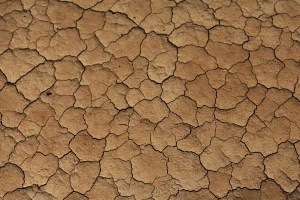
Figure 32 Hard Desert Surface
Only 20% of deserts worldwide are sand, and in some areas, like North America, sand only covers 2%. The rest is a virtual pavement of tightly packed small stones (like pebbles) left after the dust has blown away. Once this happens, the ground is stable. Therefore, it’s not accurate to always state that humanoids or hooved animals are trudging slowly through sand.
Drifting sand accumulates as a series of sand dunes, or more rarely, a single dune. Extreme temperature changes from night to day cause rocks to break apart before further eroding occurs via wind, creating sand. Some deserts feature outcropping of rocks that help form an oasis when ground water remains. Established trade routes are often used to make crossing a desert less perilous. This is where we can add a settlement; most of these are likely to be small, not a megalopolis.
Hot deserts like the Sahara and Mojave have strong winds and low humidity. Cold deserts like the Gobi occur at higher latitudes and/or altitudes. Some deserts are farther inland because moist, warm air rises over the land closer to the sea and dumps rain there, leaving none for areas farther inland, causing a desert; this means we can have a forest between our desert and the sea. Some deserts are far from oceans or other large bodies of water, but others form to leeward of a mountain range, in its rain shadow, resulting in a long narrow desert near the coast. In other words, a north-to-south coast might have a north-to-south mountain range and then a north-to-south desert on the other side.
Sandstorms and dust storms aren’t the same thing. The dramatic images of towering storms are dust storms. Sand is too heavy to be lifted that high and doesn’t get much higher than a person when blown by the wind. It’s inaccurate to state the sand is falling on people from such a storm; dust is falling. Sand will pelt people in the body and face sideways, not from above. People can die from repeated exposure to dust storms when dust causes an incurable respiratory illness that ultimately causes them to suffocate.
The post How to Create a Desert appeared first on The Art of World Building.
June 7, 2018
How to Create Marshes and Swamps
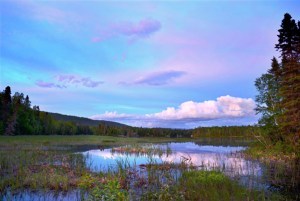
Figure 30 Marsh
Marshes
Marshes form along slow-moving rivers, at lake edges, or in depressions of land. They are often a transition between dry and wet ecosystems. Grasses and reeds dominate them (as opposed to trees) and they can be home to fish, birds, amphibians, aquatic mammals, and dangerous water-dwelling predators of our design. The water level is shallower than other wetlands. Saltwater marshes are found farther from the equator along coastlines where the tide floods them. They must be protected by lagoons or estuaries.
Swamps
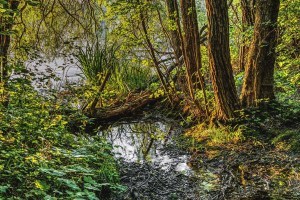
Figure 31 Swamp
A wetland with a forest is called a swamp. They occur near large rivers and lakes. A hammock is a dry land area within one, albeit with aquatic vegetation that can survive occasional flooding. The difference between a swamp forest and a brush swamp is the amount of tree cover, as the shrub version has far fewer, and shorter, trees and is instead largely bushes. The shrub version is also drier and the shrubs are mostly on the hammocks.
While elves are known for their love of forests, they don’t appear much interested in swamps, but maybe world builders can change this, creating a new variant on elves. How might these elves utilize the water and animals within it?
The post How to Create Marshes and Swamps appeared first on The Art of World Building.
June 4, 2018
Wetlands: How to Create Mires

Figure 28 Bog
A wetland develops its own water-oriented ecosystem from being saturated with water either seasonally or all year. The aquatic plant life is what distinguishes it. The water can be fresh, salt, or brackish (somewhere between). They are good places for monsters to hide, if they’re fine with being wet all the time, because humanoid species are often uncomfortable with entering wetlands; we tend to like solid ground.
There are four basic types of wetlands, and most are found in temperate climate zones or the tropics, but they can be in polar areas. Many fish species, including ones we create, use wetlands for nursery grounds, and many animals are typically found in them. This means food and products come from wetlands, including rice, honey, sugar, natural medicines, dyes and textiles.
There are far more lakes than we’re going to draw during world building. Usually we depict the largest ones, which can have mires (discussed next) at various places along their shores. Take a moment to state in your files that there are wetlands in various places on these lakes and how far these are from various settlements. While this is good, it won’t result in nearly as many wetlands as there would be, but the goal is not accuracy per se; it is including these potentially useful land features. I suggest that after building settlements, world builders take a moment to determine which settlements have a wetland nearby, what kind it is, and where it’s located in relation to the community. This will necessitate deciding there’s a smaller lake nearby, the kind not drawn on a continent-sized map.
Bogs and fens are similar types of mires. Both get water from rainfall, but fens also have surface water (water that collects on the ground, contrasted with rain or a spring). The water quality is therefore different, but your readers will not care. Both form at the edges of a lake and can eventually cover the entire surface.
Bogs
A bog forms in land depressions or old lakes, typically in the mountains in colder temperate climates. They collect deposits of dead plant material (like mosses) and form peat. The water is acidic and sometimes comes entirely from rain partly because the bog is domed-shaped land that is higher than its surroundings. A bog can be many meters deep over a wide area. Evergreen plants can grow there, including trees in drier locations, in which case the bog can appear to blend in with an evergreen forest adjacent to it.
Sometimes carnivorous plants exist in bogs. They survive by eating invertebrates. Or we can have them eat bigger animals and our species. Some large animals like moose and caribou are found in bogs, as are otters and smaller animals. Peat is itself a product that can be used for fuel (heating and cooking).
In Creating Life (The Art of World Building, #1), the possibility of undead plants was discussed. What if a bog contained undead plant material and the remains of either animal or humanoid undead? This could be where the undead emerge from and return to in between terrorizing the living.
Fens
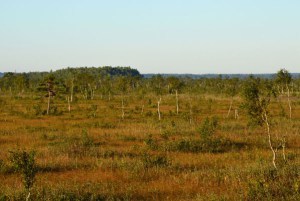
Figure 29 Avaste Fen, Estonia
Fens are similar to bogs but are covered in grasses and shrubs instead of peat, looking like meadows. They occur along lakes and rivers where seasonal changes in water level occur and are often in the mountains. Fens are located on slopes, depressions, or flat land. Water is supplied from the ground more than rain. A fen may eventually become a bog.
World builders can use fens for inventing plant life that is only found in one. Since fens are typically in the mountains, fetching an herb for a magic spell could place someone in danger from all those nasty ogres and the like that one must bypass to reach the fen. Some of the plants can be more dangerous if carnivorous and willing to consume humanoids. Since a fen looks like grassland, they can be deceptive so that characters enter them before realizing the potential dangers.
The post Wetlands: How to Create Mires appeared first on The Art of World Building.


